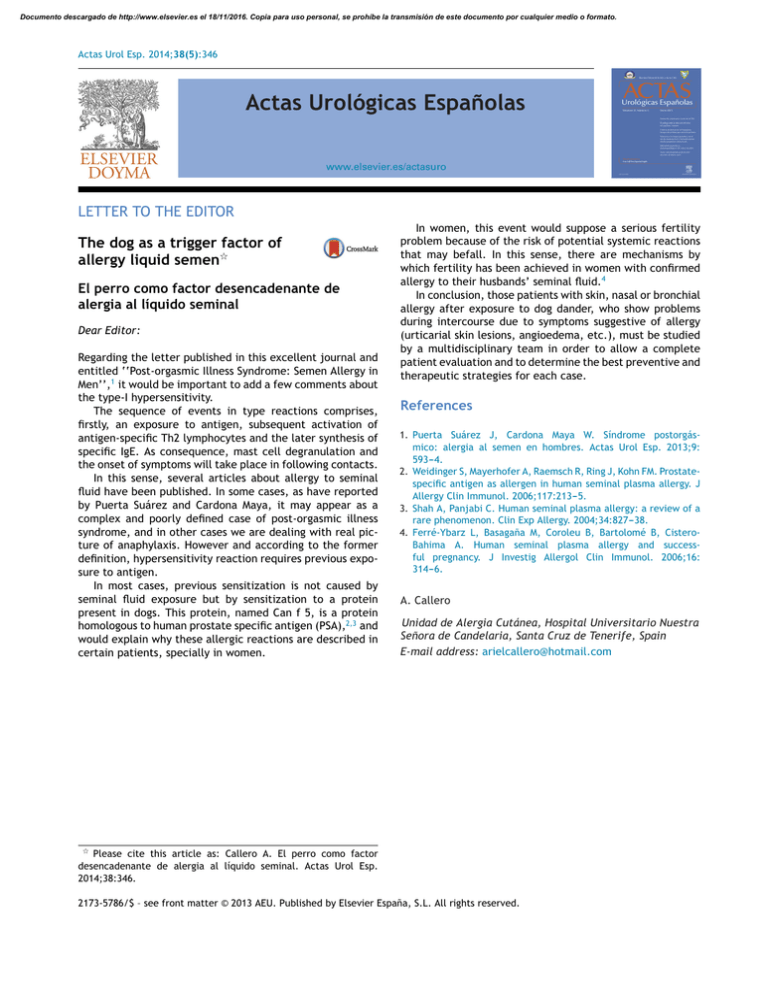Anuncio

Documento descargado de http://www.elsevier.es el 18/11/2016. Copia para uso personal, se prohíbe la transmisión de este documento por cualquier medio o formato. Actas Urol Esp. 2014;38(5):346 Actas Urológicas Españolas www.elsevier.es/actasuro LETTER TO THE EDITOR The dog as a trigger factor of allergy liquid semen夽 El perro como factor desencadenante de alergia al líquido seminal Dear Editor: Regarding the letter published in this excellent journal and entitled ‘‘Post-orgasmic Illness Syndrome: Semen Allergy in Men’’,1 it would be important to add a few comments about the type-I hypersensitivity. The sequence of events in type reactions comprises, firstly, an exposure to antigen, subsequent activation of antigen-specific Th2 lymphocytes and the later synthesis of specific IgE. As consequence, mast cell degranulation and the onset of symptoms will take place in following contacts. In this sense, several articles about allergy to seminal fluid have been published. In some cases, as have reported by Puerta Suárez and Cardona Maya, it may appear as a complex and poorly defined case of post-orgasmic illness syndrome, and in other cases we are dealing with real picture of anaphylaxis. However and according to the former definition, hypersensitivity reaction requires previous exposure to antigen. In most cases, previous sensitization is not caused by seminal fluid exposure but by sensitization to a protein present in dogs. This protein, named Can f 5, is a protein homologous to human prostate specific antigen (PSA),2,3 and would explain why these allergic reactions are described in certain patients, specially in women. In women, this event would suppose a serious fertility problem because of the risk of potential systemic reactions that may befall. In this sense, there are mechanisms by which fertility has been achieved in women with confirmed allergy to their husbands’ seminal fluid.4 In conclusion, those patients with skin, nasal or bronchial allergy after exposure to dog dander, who show problems during intercourse due to symptoms suggestive of allergy (urticarial skin lesions, angioedema, etc.), must be studied by a multidisciplinary team in order to allow a complete patient evaluation and to determine the best preventive and therapeutic strategies for each case. References 1. Puerta Suárez J, Cardona Maya W. Síndrome postorgásmico: alergia al semen en hombres. Actas Urol Esp. 2013;9: 593---4. 2. Weidinger S, Mayerhofer A, Raemsch R, Ring J, Kohn FM. Prostatespecific antigen as allergen in human seminal plasma allergy. J Allergy Clin Immunol. 2006;117:213---5. 3. Shah A, Panjabi C. Human seminal plasma allergy: a review of a rare phenomenon. Clin Exp Allergy. 2004;34:827---38. 4. Ferré-Ybarz L, Basagaña M, Coroleu B, Bartolomé B, CisteroBahima A. Human seminal plasma allergy and successful pregnancy. J Investig Allergol Clin Immunol. 2006;16: 314---6. A. Callero Unidad de Alergia Cutánea, Hospital Universitario Nuestra Señora de Candelaria, Santa Cruz de Tenerife, Spain E-mail address: arielcallero@hotmail.com 夽 Please cite this article as: Callero A. El perro como factor desencadenante de alergia al líquido seminal. Actas Urol Esp. 2014;38:346. 2173-5786/$ – see front matter © 2013 AEU. Published by Elsevier España, S.L. All rights reserved.











